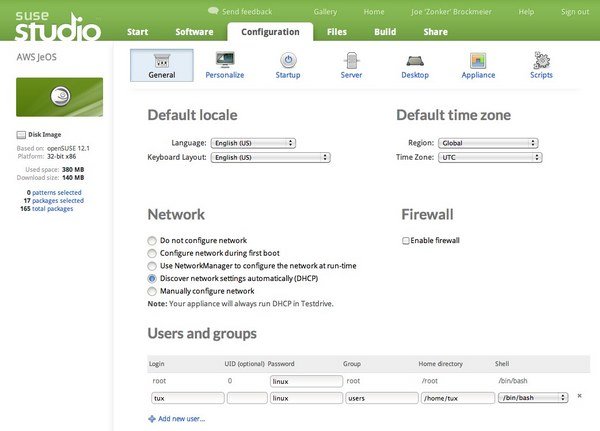To get a sense what SUSE is in for in 2012, I talked to Brauckmann this morning. Brauckmann’s involvement with SUSE started with Attachmate’s purchase, so the first time we spoke was earlier this year just after he took over the role. This time I found him much readier to discuss details of the SUSE strategy, if not every minor product detail.
Cloud Focus
The big focus for SUSE in 2012 will be the enterprise server market, naturally. According to the platform lifecycle that SUSE provided today, expect to see SUSE Linux Enterprise Desktop 11 service pack 2 (SP2) sometime in the first quarter, and SP3 late in 2012 or later. SUSE Linux Enterprise 12? We won’t be seeing a major refresh until 2013.
SUSE announced its commitment to OpenStack in October, along with a development preview available via SUSE Studio. This includes the three major components in the Diablo release (Nova, Glance, and Keystone). Brauckmann wasn’t sure about specific contributions that SUSE would be making to OpenStack, but did say that the company plans to follow up with a second technology preview in Q2 of 2012. (The “Essex” release of OpenStack will come out in late Q1 if it sticks to schedule.)
When’s a SUSE-based OpenStack offering going to be production ready? Probably no sooner than Q4 of 2012, after the Essex+1 release of OpenStack. I asked Brauckmann if this was trailing the market a bit, considering that VMware, Eucalyptus and Amazon Web Services (among others) are already being widely used. Brauckmann says that they’re in conversations with SUSE customers and that they seem to be in sync with actual enterprise deployment plans for private clouds.

Though a minor update, SP2 should bring some important features to SLES. For example, in addition to the usual driver updates and such, Brauckmann says that SUSE will be rolling out btrfs support for copy on write (COW), checksumming and filesystem snapshots. They’ll also be providing support for Linux Containers (LXC) and YaST and Zypper (SUSE management and software management tools, respectively) will have features to manage system snapshots and rollbacks.
Though SUSE isn’t quite ready yet to host private clouds, the company is well under way with its plans to be a good guest in the clouds. Brauckmann mentioned the SUSE Studio 1.2 release earlier this year, and the ability to build custom versions of SUSE and openSUSE and deploy them directly to Amazon Web Services (AWS) from SUSE Studio. Assuming that companies want to deploy an OS with the application (instead of just deploying an application on a PaaS provider), SUSE is in a pretty good position here.
Another area that SUSE is in a good position, but you don’t hear much about, is embedded in storage devices and other appliances. For example, Brauckmann mentioned one major customer – GE Healthcare – that is using SUSE Linux for some of its medical devices. However, SUSE is essentially an invisible part of the system and doesn’t get a lot of notice for its role there.
Desktop
One of the lingering questions over SUSE right now is the fate of its desktop offering, SUSE Linux Enterprise Desktop (SLED). If you comb carefully through Novell and SUSE announcements from the last two years, you’ll find little if any mention of the plans for SLED. This morning, Brauckmann noted that when they were planning for products to focus on and products to discontinue, SLED fell… someplace in the middle.
Brauckmann says that the three focus areas for SUSE are “enterprise computing, cloud and cloud infrastructure, and integrated systems.” But when the question about what to stop doing, SLED didn’t make that list either. So SUSE will continue to “invest in the desktop,” but the lack of attention effectively ensures that SLED isn’t going to be a growth area for the company in 2012, and certainly not a focus area.
I also asked about SUSE’s commitment to LibreOffice, and Brauckmann hedged a bit about talking numbers. Since SUSE is no longer attached to a public company, they’re not obligated to provide any sales figures, Brauckmann noted. The company policy, he says, is not to provide numbers. However, when I pressed about LibreOffice’s general prospects he indicated that when averaged out it was a “slightly growing” portion of the SUSE business.
Brauckmann also specifically called out SUSE’s relationship with the openSUSE community, and noted that the company had been keeping its promises to support and work with the openSUSE community. Indeed, the openSUSE community does seem to be thriving these days. The 12.1 release, aside from the silly version bump (from 11.3 to 12.1 with no intermediate 12.0) is one of the best openSUSE releases in some time.
Going into 2012
Going into 2012, SUSE looks like it’s in a solid position. I don’t see any indication that SUSE is poised to try to take the crown from Red Hat, or make any risky moves at all. But it does seem like it’s in good shape to keep its share of the enterprise market and maybe start carving out a position as the preferred private IaaS on top of OpenStack. Since Red Hat isn’t one of the many joining the OpenStack chorus, it’s between SUSE and Canonical to carve out that market – if it appears. Given that SUSE has a long history with enterprise customers, they’ll have a good shot at a lot of that business.
It hasn’t been easy being green for many years, but it looks like 2012 is going to be a bit easier than the last few for SUSE.
Article source: RRW http://feedproxy.google.com/~r/readwriteweb/~3/oMajC3QEjY0/whats-in-store-for-suse-in-201.php